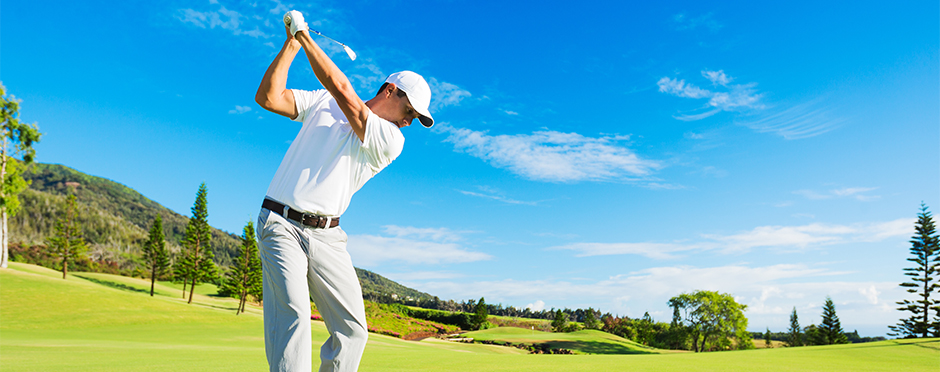
7 Tips To Prevent Golf Injuries
Leave a CommentGolf is typically viewed as a low-intensity, relaxing outdoor sport. During golf, our bodies are not subjected to the same stress as basketball or running a marathon. That being said, every sport comes with the risk of injury and golf is no different. Amateurs and professionals alike can have golf seasons ruined as a result of a golf-related injury. What many people may not realize, however, is that physical therapists are trained to help you after an injury and prevent injuries from occurring in the first place.
The best time to prevent a golf injury is during the off season, which for those of us in northern climates is over the winter months. Most golf courses are closed in the winter (except you, sunny Florida) removing the temptation to play through an injury. Once the season starts, you want to maintain the momentum of injury prevention habits you built over the winter. In this article we will discuss 7 tips to prevent injuries in golf, both during preseason and during the golf season.
-
Focus On Preseason Strength
The main areas to target are your shoulders, forearms, back and hips. These areas are most involved in a golf swing. Strengthening these areas serves two purposes. First, a stronger joint is less likely to be injured. Building strength is one of the best methods to avoid an injury. Second, getting these key areas stronger also gives you more power to your swing. Who doesn’t want more yards from their driver?
-
Maintain A Mobility Routine
The same areas you want to be strong are what you want to mobilize. Here is an example for each:
Shoulders – Wall Book Openers
Kneel with both arms against a wall, and closer knee down on the floor. Rotate your outside arm towards the wall behind you, following your hand with your head. Keep your outside knee pointing forward, avoiding the temptation of letting that knee follow the rotation. Return to the starting position and repeat 10 times, on both sides.
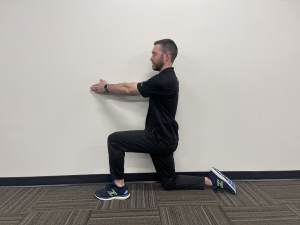
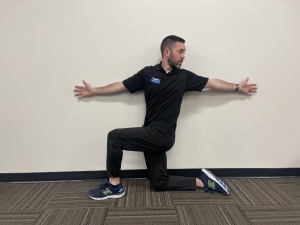
Forearms – Prayer And Reverse Prayer
Touch your palms against each other in front of your chest. Now lower your hands until your wrists make a 90-degree angle. Repeat 10-15 times. For the reverse motion, start with the back of your hands against each other in front of your chest, but start lower. Now raise your hands until your wrists make another 90-degree angle.
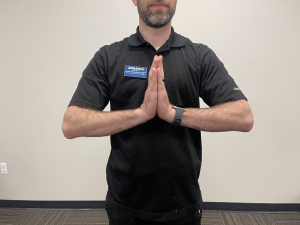
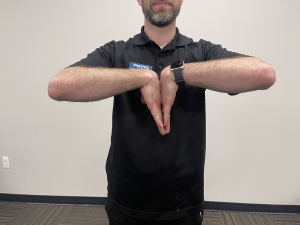
Back – Child’s Pose With Side Bend
Kneel down with your hips as low towards your heels as you can tolerate. Walk your hands straight out, and then arch towards one side. Hold that position for 45-60 seconds, then walk back to the start. Repeat on the other side.
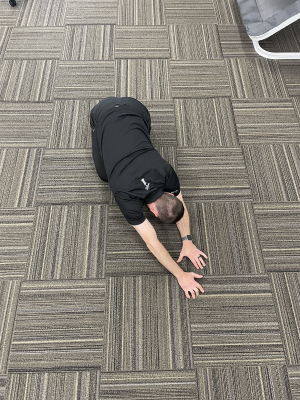
Hips – Runner’s Lunge
Start in a tall plank position with your left foot planted outside your left hand. If you can’t reach you leg up this far aim wider, making sure you get the left heel planted. Then holding your lower body steady, rotate your left hand up towards the ceiling, pause, and return. Repeat this 5-10 times and then complete on the other side.
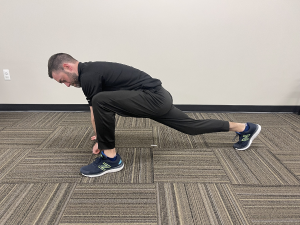
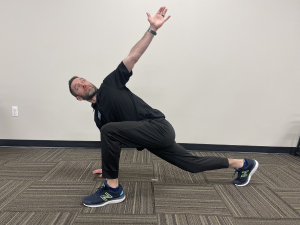
-
Start The Season Slow
Even with strength, mobility, and practice swings during the preseason, your body is not used to the same volume of golf during the spring that you might be able to handle mid-summer. For your first couple of times playing golf for the season, you should stick to 9 holes. Jumping right into a full 18 holes, or more, can lead to an early season overuse injury. Instead, focus on the first 9 holes of the season to assess for any soreness. If playing 9 holes results in a sore shoulder, give more attention to strength and mobility for the following week. Reassess the following week to see if your hard work paid off – less shoulder pain.
-
Warmup Before The Range Or The First Tee Box
Walking straight from your car to the First tee box and taking a full swing with the driver sounds like a bad idea just reading about it. Yet, many golfers take this same approach, especially if they are running late on league night. Even if all you have is five minutes, warmup before the first hole to prevent an injury. Golf, like any sport, requires a targeted warmup for best performance as well as prevention of injury. The main goal of a warmup is to raise your body temperature (and therefore how warm your muscles are) and take your joints through gradually more full range of motion. Roll your shoulders, perform some leg swings, and rotate your trunk from side to side. Going through those three motions 5-10 times each can be considered the minimum.
-
Use Appropriate Footwear
Golf spikes are designed to keep your feet planted while you swing. This is especially important during the follow-through phase when you have a large rotational force passing through your body. When you are new to golf you may assume that normal trainers or running shoes will suffice. However, poor footing during your follow-through can lead to foot slippage. This slip, if minor, can strain your ankles. A more significant loss of footing can pull on your hip and back, resulting in a more significant muscle strain. Investing in proper footwear is an easy preventive measure.
-
Stay Hydrated And Wear Sunscreen
Dehydrated muscles are less stretchy, therefore more likely to strain. When playing golf out in the heat aim for 24-32 ounces of water per hour, according to the CDC1. And sorry, beer and liquor don’t count towards this target. Alcohol is a diuretic, flushing water from the body. Drinking beer on the golf course on a hot day will speed up the process of dehydration. Consider water intake the lubrication to your swing, in that it prevents excess wear and tear. The same concept applies to sunscreen use. A sunburned patch of skin is less flexible. This can lead to reduced range in your backswing, or poor deceleration in your follow-through. Wear your sunscreen out on the course!
-
Address Aches And Pains Early-On With A Free Assessment
Athletico offers free assessments, and many skilled physical therapists specializing in golf-specific rehabilitation. Your physical therapist can tell you what key parts of your body or phases of your swing might predispose you to injury. From there, the two of you can develop a plan to address those issues before losing time on the course! Free Assessments are available in-clinic and virtually through our Telehealth platform.
*Per federal guidelines, beneficiaries of plans such as Medicare, Medicaid, Tricare, VHA and other federally funded plans are not eligible for free assessments.
The Athletico blog is an educational resource written by Athletico employees. Athletico bloggers are licensed professionals who abide by the code of ethics outlined by their respective professional associations. The content published in blog posts represents the opinion of the individual author based on their expertise and experience. The content provided in this blog is for informational purposes only, does not constitute medical advice and should not be relied on for making personal health decisions.
Reference:
1. https://www.cdc.gov/niosh/mining/userfiles/works/pdfs/2017-126.pdf
